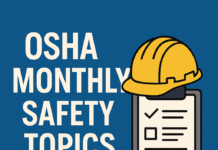
How to Become a OSHA Lead Auditor?
Introduction
In today’s dynamic work environment, safety is paramount, and organizations are increasingly realizing the importance of adhering to Occupational Safety and Health Administration (OSHA) standards. One pivotal role in ensuring compliance is that of an OSHA Lead Auditor. Let’s delve into the journey of becoming a proficient OSHA Lead Auditor, exploring the steps, challenges, and rewards along the way.
Understanding OSHA Standards
Before embarking on the path to becoming a lead auditor, it’s crucial to have a solid understanding of OSHA regulations. These standards are in place to guarantee a safe and healthy working environment for employees. The need for compliance not only ensures the well-being of workers but also protects organizations from potential legal repercussions.
Roles and Responsibilities of a Lead Auditor
As an OSHA Lead Auditor, your responsibilities go beyond merely conducting audits. You’ll be tasked with ensuring that safety protocols are implemented and followed rigorously. This includes thorough reporting and documentation of your findings, providing valuable insights to improve workplace safety.
Qualifications and Skills
To excel in this role, a combination of education, certifications, and soft skills is essential. A background in occupational safety or a related field is often required. OSHA-approved certifications add credibility, while effective communication and problem-solving skills are crucial for success.
Training Programs Available
Several training programs are available to aspiring OSHA Lead Auditors. These OSHA-approved courses cover the necessary topics and provide a structured learning environment. The practical application of knowledge is emphasized, preparing individuals for real-world auditing scenarios.
Gaining Practical Experience
While theoretical knowledge is crucial, practical experience is equally vital. Seek opportunities for on-the-job training or internships in organizations where OSHA compliance is a priority. Networking within the industry can open doors to valuable experiences and mentorship.
Preparing for the OSHA Lead Auditor Exam
The journey to becoming a lead auditor culminates in the OSHA Lead Auditor Exam. Understanding the exam structure, utilizing comprehensive study materials, and practicing with mock exams are essential steps in preparation.
Tips for Success in the Exam
Time management is key during the exam. Focus on key areas such as hazard identification, risk assessment, and OSHA standards. Consider engaging in mock interviews to simulate the exam environment and build confidence.
Career Opportunities for OSHA Lead Auditors
A certified OSHA Lead Auditor opens doors to diverse career opportunities. Industries ranging from manufacturing to healthcare actively seek auditors to ensure compliance. Advancement prospects are promising, and job satisfaction comes from knowing you contribute to a safer work environment.
Challenges Faced by OSHA Lead Auditors
Despite the fulfilling nature of the role, OSHA Lead Auditors face challenges. Staying abreast of evolving standards, handling difficult situations during audits, and maintaining a work-life balance are aspects that require careful consideration.
Industry Recognition and Accreditation
Choosing OSHA-approved organizations for accreditation is crucial. The benefits extend beyond personal growth to professional recognition, establishing credibility in the field.
Networking and Professional Associations
Joining relevant professional associations and attending networking events are invaluable. Connecting with peers and staying updated with industry trends enhances your knowledge and opens doors to new opportunities.
Continuous Learning and Development
The commitment to continuous learning is a hallmark of successful OSHA Lead Auditors. Explore online courses, webinars, and attend conferences to stay updated with the latest developments in occupational safety.
To become an OSHA (Occupational Safety and Health Administration) Lead Auditor, you need to follow certain steps and acquire specific qualifications. OSHA Lead Auditors play a crucial role in ensuring workplace safety and compliance with OSHA standards. Here's a general guide on how to become an OSHA Lead Auditor:- Educational Background:
- Obtain a relevant educational background in occupational safety and health, industrial hygiene, environmental science, or a related field. A bachelor’s degree in occupational safety or a related discipline is often preferred.
- Gain Work Experience:
- Acquire practical experience in the field of occupational safety and health. Most OSHA Lead Auditors have several years of experience working in safety-related roles.
- Understand OSHA Standards:
- Develop a strong understanding of OSHA regulations and standards. Familiarize yourself with the specific industry standards that apply to your area of expertise.
- Attend OSHA Training Courses:
- Participate in OSHA training courses relevant to your field. OSHA offers various training programs and courses that cover different aspects of workplace safety.
- OSHA Outreach Training:
- Consider completing the OSHA Outreach Training Program, which offers courses for both workers and employers. The courses cover general industry and construction standards and provide a solid foundation in OSHA regulations.
- Gain Certification:
- Obtain relevant certifications that demonstrate your expertise in occupational safety. Certifications such as the Certified Safety Professional (CSP) or the Occupational Health and Safety Technician (OHST) may enhance your credentials.
- Lead Auditor Training:
- Enroll in a Lead Auditor training program accredited by a recognized certification body. These programs often cover the principles of auditing, documentation, and compliance with OSHA standards.
- Acquire Auditing Experience:
- Gain practical auditing experience by participating in OSHA audits or similar safety audits. This hands-on experience is valuable in applying theoretical knowledge to real-world situations.
- Stay Informed:
- Stay updated on changes to OSHA regulations and industry best practices. Continuous education and staying informed about the latest developments in occupational safety are crucial for maintaining your qualifications.
- Apply for Lead Auditor Certification:
- Once you have met the necessary education and experience requirements, apply for OSHA Lead Auditor certification through a recognized certifying body. Certification bodies may have specific eligibility criteria, so ensure that you meet all the requirements before applying.
- Maintain Certification:
- Maintain your OSHA Lead Auditor certification by fulfilling any ongoing education or professional development requirements set by the certifying body. This may include attending workshops, conferences, or completing additional training courses.
Becoming an OSHA Lead Auditor requires a combination of education, experience, training, and certification. By following these steps, you can build a strong foundation for a career in occupational safety and health auditing.Conclusion
Becoming an OSHA Lead Auditor is a fulfilling journey that requires dedication, continuous learning, and a commitment to ensuring workplace safety. As you navigate the challenges and celebrate the successes, remember that your role is pivotal in creating a safer, healthier work environment for all.
OSHA Construction Safety Checklist
OSHA Construction Site Requirements
OSHA Safety Plan for Construction
OSHA Safety and Health Management System
FAQs
- Is a specific educational background necessary to become an OSHA Lead Auditor?While a specific background in occupational safety or a related field is beneficial, individuals from various educational backgrounds can pursue this career. OSHA-approved certifications often play a crucial role in qualifying for the role.
- How long does it typically take to become a certified OSHA Lead Auditor?The duration varies, but it often involves a combination of education, training programs, and practical experience. On average, the process can take several months to a few years.
- What are the key skills needed for success in this role?Effective communication, problem-solving, attention to detail, and a strong understanding of OSHA standards are key skills for success as an OSHA Lead Auditor.
- Are there ongoing requirements for maintaining OSHA Lead Auditor certification?Yes, maintaining certification often involves continuing education and staying updated with changes in OSHA regulations. This ensures auditors remain informed and effective in their roles.
- Can I specialize in a specific industry as an OSHA Lead Auditor?Yes, OSHA Lead Auditors often have the flexibility to specialize in specific industries, such as construction, healthcare, or manufacturing, based on their interests and expertise.
























